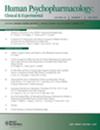Effects of atypical antipsychotics on serum asprosin level and other metabolic parameters in patients with schizophrenia
Abstract
Background
In this cross-sectional study, we compared fasting serum asprosin levels and metabolic parameters between patients receiving one of three atypical antipsychotics (olanzapine, risperidone, or aripiprazole) and healthy subjects.
Methods
The study population included 62 adult outpatients with schizophrenia and 22 healthy controls, matched for age and gender. Patients were in remission and had been on stable monotherapy with one of these atypical antipsychotics for over 6 months. Body Mass Index (BMI) and fasting serum levels of asprosin, glucose, HA1c, insulin, and lipid profile were compared across the investigated groups. Additionally, the number of participants meeting the insulin resistance criterion, defined as homeostasis model assessment for insulin resistance (HOMA-IR) >2.5, as well as the number of participants with elevated BMI levels (men >27 kg/m2, women >25 kg/m2) were compared among the groups.
Results
We observed statistically significant differences in BMI and fasting serum levels of glucose, HA1c, insulin, triglyceride (TG), high-density lipoprotein cholesterol, and asprosin among patients receiving olanzapine or risperidone, as compared to those receiving aripiprazole and healthy subjects. Patients on aripiprazole exhibited values comparable to healthy subjects, whereas those on risperidone or olanzapine showed significantly higher values, with the highest observed in the olanzapine group. Additionally, the prevalence of participants meeting the insulin resistance criterion and those with elevated BMI was also greater in individuals receiving olanzapine or risperidone compared to those on aripiprazole and healthy subjects. Serum asprosin levels showed a significant positive correlation with BMI and several metabolic parameters, including HbA1c, fasting insulin, HOMA-IR, and TG. No significant differences were observed among the investigated groups in terms of serum levels of total cholesterol and low-density lipoprotein cholesterol.
Conclusions
Our cross-sectional study highlights the association between elevated asprosin levels, weight gain, and metabolic disorders in patients treated with olanzapine and risperidone. Given the bidirectional nature of the relationship between serum asprosin levels and these metabolic disturbances, further research is warranted to elucidate potential causative pathways.

 求助内容:
求助内容: 应助结果提醒方式:
应助结果提醒方式:


